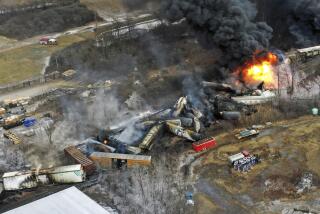Union Pacific Switches Tracks, Predicts Loss
Union Pacific Corp., parent of the nation’s largest railroad, warned Thursday of likely first-quarter losses because of nationwide rail service troubles and the need to spend hundreds of millions of dollars to upgrade its system.
Analysts expressed surprise because the company said just last month that it was profitable. The nation’s largest railroad said the outlook had changed in recent weeks because its strategy of running trains in a single direction on one track isn’t working. The strategy was its latest ill-fated attempt to resolve an eight-month logjam resulting from its $5.4-billion acquisition of Southern Pacific Rail Corp. in 1996.
Union Pacific said it plans to raise as much as $1 billion this year to expand rail yards and tracks by issuing equity-linked securities. The company has yet to determine the form of the securities or when they will be issued, Union Pacific spokesman Gary Schuster said.
Although it was not entirely clear whether any improvements would be made in Southern California, officials of the ports of Los Angeles and Long Beach, two of the nation’s busiest, welcomed the news. Late last year, the ports experienced tie-ups because of UP’s problems, which included a shortage of rail cars and labor. The shortages forced shippers to divert some vessels to other West Coast ports and caused delays in getting merchandise to retailers during the holiday season.
“Needless to say, we welcome Union Pacific’s investment,” said Yvonne Avila, spokeswoman for the Port of Long Beach, where traffic has been increasingly heavy because of rising imports from Asia and the generally strong economy.
“The congestion created by a lack of equipment and service by the UP Railroad during the holiday season was totally unacceptable,” she said. “We are pleased to hear that they are now investing in their system.”
At the Port of Los Angeles, meanwhile, marketing manager John Cushing said 1998 has so far been congestion-free, but he added that the port will continue to press Union Pacific to buy more containers.
“They’ve advised us that they have invested heavily in new railroad equipment and locomotives and we’re confident that they will alleviate the problems that are here in Southern California,” Cushing said.
The Dallas-based company on Thursday also cut its quarterly dividend to 20 cents a share, down from 43 cents. The cut, if maintained over a year, would amount to a reduction of $230 million in the company’s payout to shareholders.
After the announcement, the company’s stock tumbled $6.56, or 11%, to $52.06 in New York Stock Exchange trading.
“They need more than a Band-Aid approach,” said Furman Selz analyst Doug Rockel. “It’s good news for shippers but a negative announcement for shareholders,” at least initially.
Union Pacific’s business could be hurt “perhaps a little bit into the second quarter while we get this thing back on its feet,” Chairman and Chief Executive Dick Davidson said.
Standard & Poor’s Corp. cut its rating on Union Pacific’s commercial paper, and said it may lower its corporate credit, senior secured and unsecured debt ratings. Moody’s Investors Service downgraded the company’s senior unsecured debt rating.
Union Pacific has lost sales as it failed to deliver goods on time and shippers turned to other railroads or trucks. The company’s expenses have also risen as it pays overtime to crews and incurs other costs to try to clear up its lines.
Economists estimate the logjam has cost U.S. businesses about $2 billion, with as much as half of the damage in Texas. Shippers are pressuring federal regulators to consider ordering Union Pacific to sell some track to give shippers more alternatives for rail transportation.
The company’s shares have fallen about 26% since July 1. Thursday’s steep share price decline dropped Union Pacific’s market value by as much as $2.4 billion.
More to Read
Sign up for Essential California
The most important California stories and recommendations in your inbox every morning.
You may occasionally receive promotional content from the Los Angeles Times.










